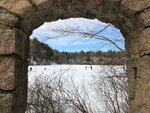




Mason Augustus Walton was born to Irish immigrants on July 31, 1838 in the Penobscot Indian settlement of Old Town, Maine. Amongst his five siblings, Mason was the quiet adventurer. As a schoolboy, he explored miles of forest along the Penobscot River, mesmerized by hibernating animals and migrating birds.
At age eight, Walton and his father took a guided tour with Joe Polis, an esteemed Penobscot who once escorted Thoreau through the same trails. Polis explained that animals were intelligent and communicated with each other; how birds used different vocalizations to announce food sources, claim territory and warn of predators.
Walton was enchanted.
A gifted student, Walton studied ornithology and botany. He spent memorable summers working on a fishing schooner and talking politics at the farmstead of his best friend, Cyrus, son of Maine senator Hannibal Hamlin; Abe Lincoln’s eventual vice president.
When Civil War erupted, Walton couldn’t enlist due to a chronic leg injury. Then a series of heartaches befell him. His older brother, George, a Union soldier, was killed in the Battle of Fair Oaks. Weeks later, brother Brainard, a naval officer, died at sea.
During post-War Reconstruction, Cyrus Hamlin, by then a decorated Army captain, contracted yellow fever and died at 28.
In his private life, he was smitten by Olive Bradford, a childhood friend of his sister’s. They married and lived happily on a farm near Old Towne for seven years. But then, tragedy struck again. While giving birth, Olive passed away; their unnamed daughter died hours later. For months, Walton secluded himself at the farm to grieve.
He rejoined society in his 40s, writing for The Bangor Record and bookkeeping for a pharmaceutical company. When the business transferred to Boston, Walton, barely above the poverty line, left the farm for the city.
Overwhelmed by urban life, Walton developed a severe respiratory infection, allergies and indigestion. His doctor suggested he live in a forest. Recalling his summer on a schooner, Walton thought ocean air was a better remedy.
Raspy and frail, he boarded the City of Gloucester steamboat in the summer of 1884 and landed at Steamboat Wharf on Duncan Street. He trekked from dock to dock, begging skippers to bring him aboard, but he was refused for looking too sickly, which captains saw as a bad omen. Dejected, Walton camped atop Bond’s Hill, the imposing hill overlooking the back of Stage Fort Park, with only a cotton tent for shelter.
Enamored with the active forest life and working waterfront, Walton nursed himself back to health by eating fruits and berries. He explored the woods, learned the landscape and befriended farmers and fishermen. His health—and moxie—returned. Gloucester became home.
After a storm destroyed his tent, Walton received permission from Walter Cressey, founder of R. B. Strong, to build a cabin at Old Salem Road, a carriage path that went south toward Magnolia and had been abandoned for over 100 years.
It’s then that Walton dedicated his life to nature studies, consorting with birds and animals who became lifelong pets. He kept volumes of notes to satisfy his curiosities and answer the question: Is animal behavior hereditary or taught?
Walton submitted a series of popular nature essays to Forest and Stream magazine under the pen name, Hermit. The essays accentuated animal intelligence. Almost overnight, The Hermit earned a worldwide following.
People of all stripes sought the mysterious man in the woods, but The Hermit was no recluse. He accepted visitors at all hours, adored children and conducted field trips from Freshwater Cove and Buswell Pond through the Magnolia Swamp. He embraced Gloucester and Gloucester loved him back.
When philanthropist Samuel Sawyer died in 1899, he designated 600 acres around Bond’s Hill as a nature reserve named Ravenswood Park. The Trustees purchased Cressey’s land along Old Salem Road; trails were cleared and maintained. Mason Walton, anointed “The Hermit of Ravenswood,” was allowed to stay as the nature reserve’s only tax-paying resident.
In 1903 at age 65, A Hermit’s Wild Friends, Walton’s account of 18 years in Ravenswood and his relationship with wildlife, was published. The Hermit continued studying wildlife, hosting scores of visitors, and guiding tours for more than a dozen years.
During a wellness check in May of 1917, a park steward found The Hermit in his cabin, dazed and freezing. He was transported by horse-drawn ambulance to the Alms House hospital and diagnosed with bronchial pneumonia. Two weeks later, he passed away. Mason Walton was 78.
The Hermit is buried with his wife and daughter by their farm in Maine. During The Hermit’s 33 years in the Gloucester woods, more than 50,000 people signed his guest book.
Today, thousands traverse Ravenswood Park along the trails Mason Walton blazed over 100 years ago. Though his cabin was destroyed by fire in 1948, a plaque rests there off Old Salem Road for nature lovers to honor The Hermit.